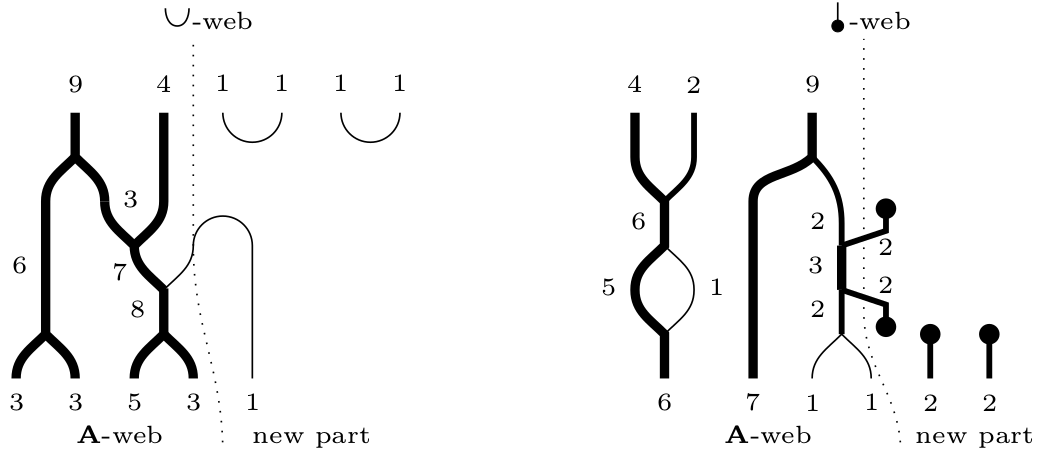Data
- Title: Webs and q-Howe dualities in types \(\mathbf{B}\mathbf{C}\mathbf{D}\)
- Authors: Antonio Sartori and Daniel Tubbenhauer
- Status: Trans. Amer. Math. Soc. 371 (2019), no. 10, 7387-7431. Last update: Tue, 3 Apr 2018 13:17:55 EST
- ArXiv link: https://arxiv.org/abs/1701.02932
- ArXiv version = 0.99 published version
- LaTex Beamer presentation: Slides1, Slides2
Abstract
We define web categories describing intertwiners for the orthogonal and symplectic Lie algebras, and, in the quantized setup, for certain orthogonal and symplectic coideal subalgebras. They generalize the Brauer category, and allow us to prove quantum versions of some classical type \(\mathbf{B}\mathbf{C}\mathbf{D}\) Howe dualities.
A few extra words
Consider the following question: Given some
Lie algebra \(\mathfrak{g}\), can one
give a generator-relation
presentation
for the
category of its finite-dimensional representations,
or for some well-behaved
subcategory?
Maybe the best-known instance of this
is the case
of the monoidal category generated by the vector
representation of (quantum) \(\mathfrak{sl}_2\). Its
generator-relation
presentation is known as the
Temperley-Lieb category and goes back to
work of Rumer-Teller-Weyl and Temperley-Lieb.
Several generalizations of this were found over the years. The most
important one for our paper was
seminal work of Cautis-Kamnitzer-Morrison
who a generator-relation presentation of the monoidal category
generated by (quantum) exterior powers of the vector representation of
quantum \(\mathfrak{gl}_n\).
Their crucial observation was that a classical tool
from representation and invariant theory, known as
skew Howe duality, can be quantized
and used as a device to describe intertwiners of quantum \(\mathfrak{gl}_n\).
The diagrammatic presentation is provided by so-called
(type) \(\mathbf{A}\)-web categories.
The idea
which started this paper was to
apply Cautis-Kamnitzer-Morrison's approach to
types \(\mathbf{B}\mathbf{C}\mathbf{D}\).
However, quantization outside of type \(\mathbf{A}\)
turns out be be quite delicate. In particular, we cannot
use the road map given by Cautis-Kamnitzer-Morrison since
quantization of Howe's classical dualities in types \(\mathbf{B}\mathbf{C}\mathbf{D}\)
is not a straightforward affair.
To overcome this problem, we consider
alternative quantizations in types \(\mathbf{B}\mathbf{C}\mathbf{D}\)
provided by so-called coideal subalgebras of quantum \(\mathfrak{gl}_n\).
(In short, these have “nicer” quantum factors than the quantum enveloping algebras,
but worse “topological behaviour”.)
Our approach then goes as follows:
In order to quantize Howe dualities in types
\(\mathbf{B}\mathbf{C}\mathbf{D}\), we define
extended web categories,
which we call cup- and
dot-web categories, and prove that
they act on
the representation categories of the coideal subalgebras.
(And they provide diagrammatic descriptions of these categories
by playing the roles of “thickened” Brauer categories.)
We
will then show that these extended web categories
can be used to
recovering some versions of quantum Howe duality in types
\(\mathbf{B}\mathbf{C}\mathbf{D}\).
Note that our approach goes somehow
the opposite way with respect to Cautis-Kamnitzer-Morrison's road map:
instead of
using quantum Howe duality to obtain a
web calculus, we use our web categories to prove quantized Howe dualities.
We define these cup- and dot-web categories in our paper.
All the reader needs to know about them
before looking into the paper is summarized in the Figure below.

Note that these can be seen as “extended type \(\mathbf{A}\) webs”.
